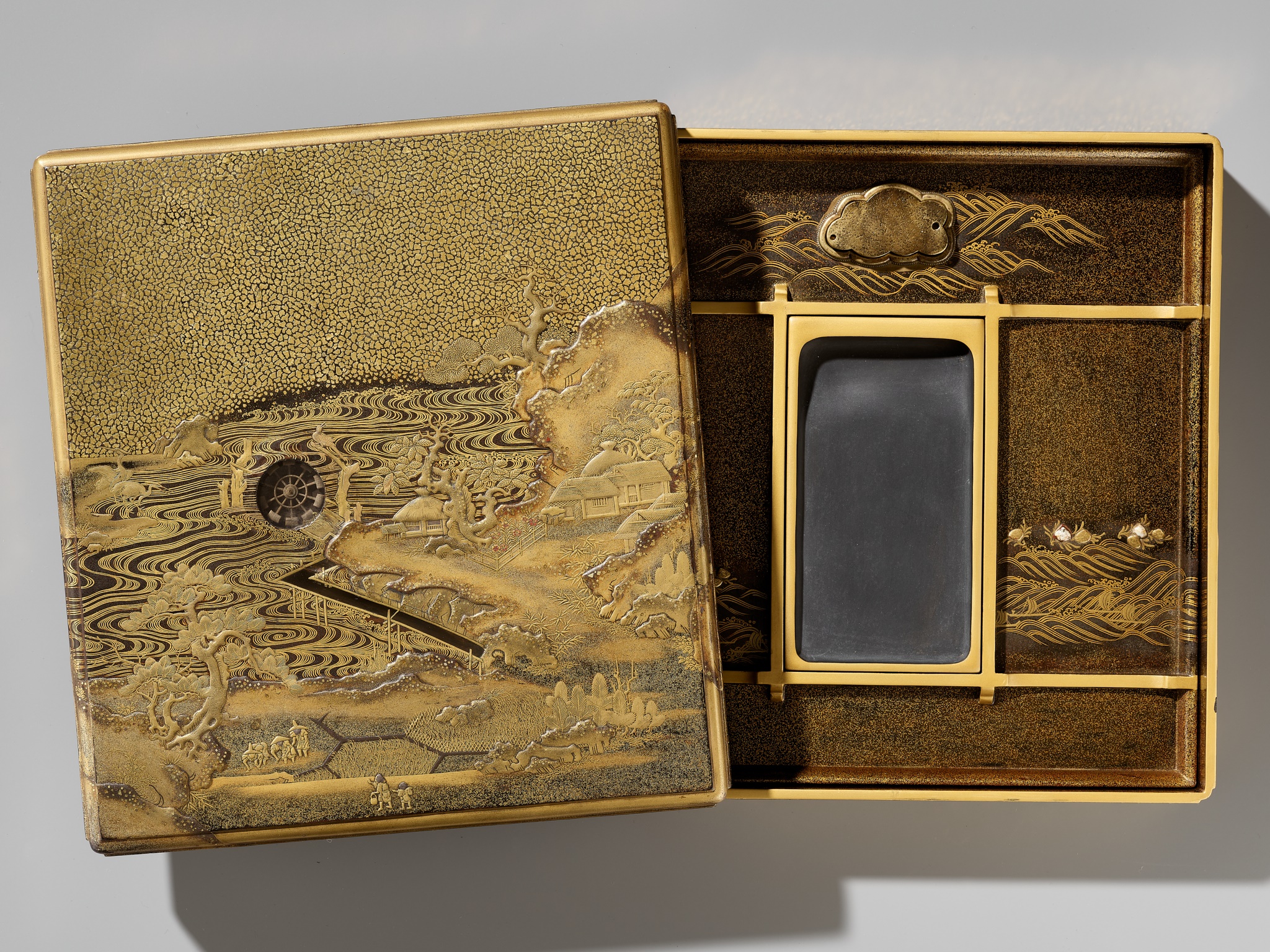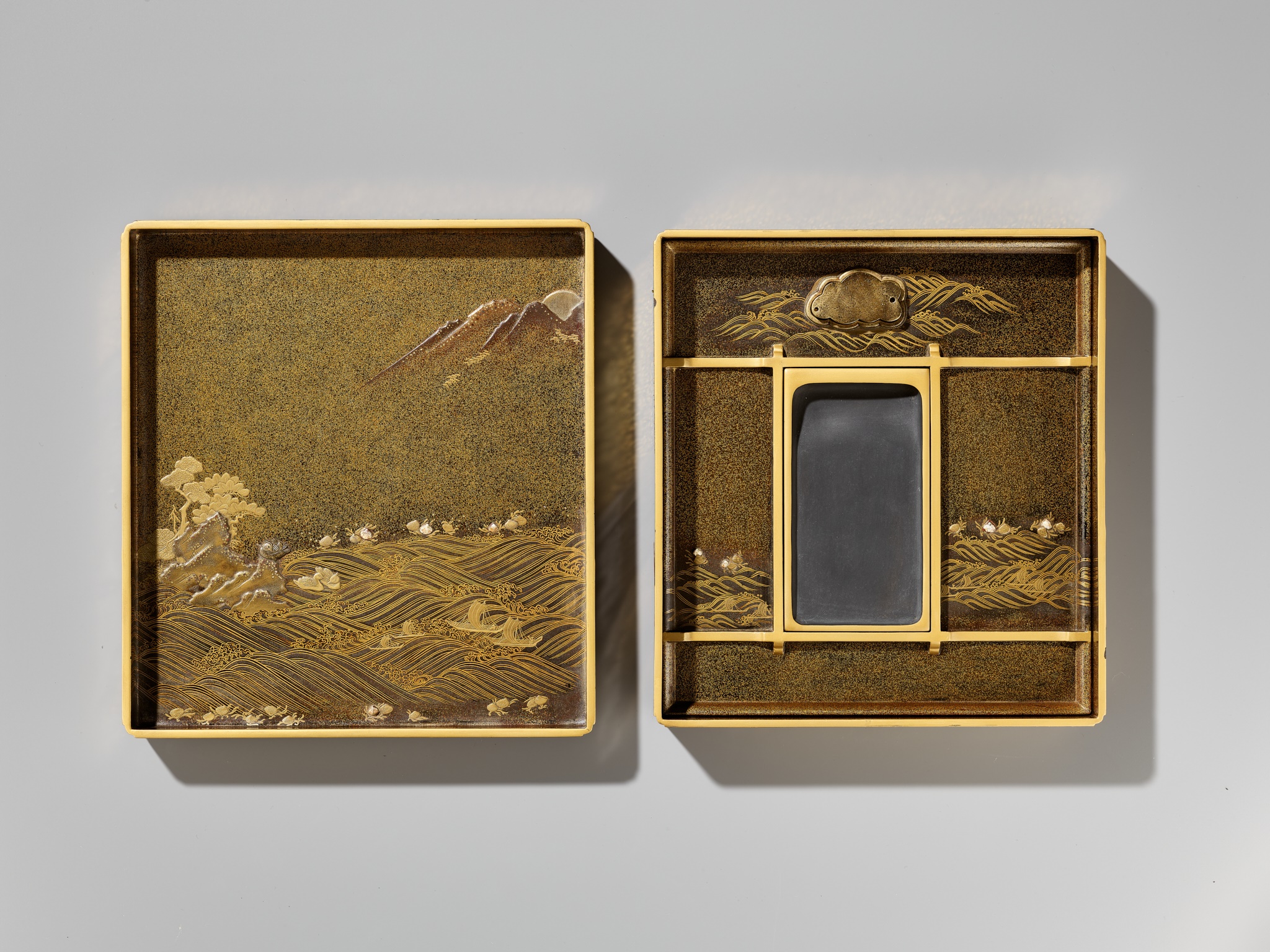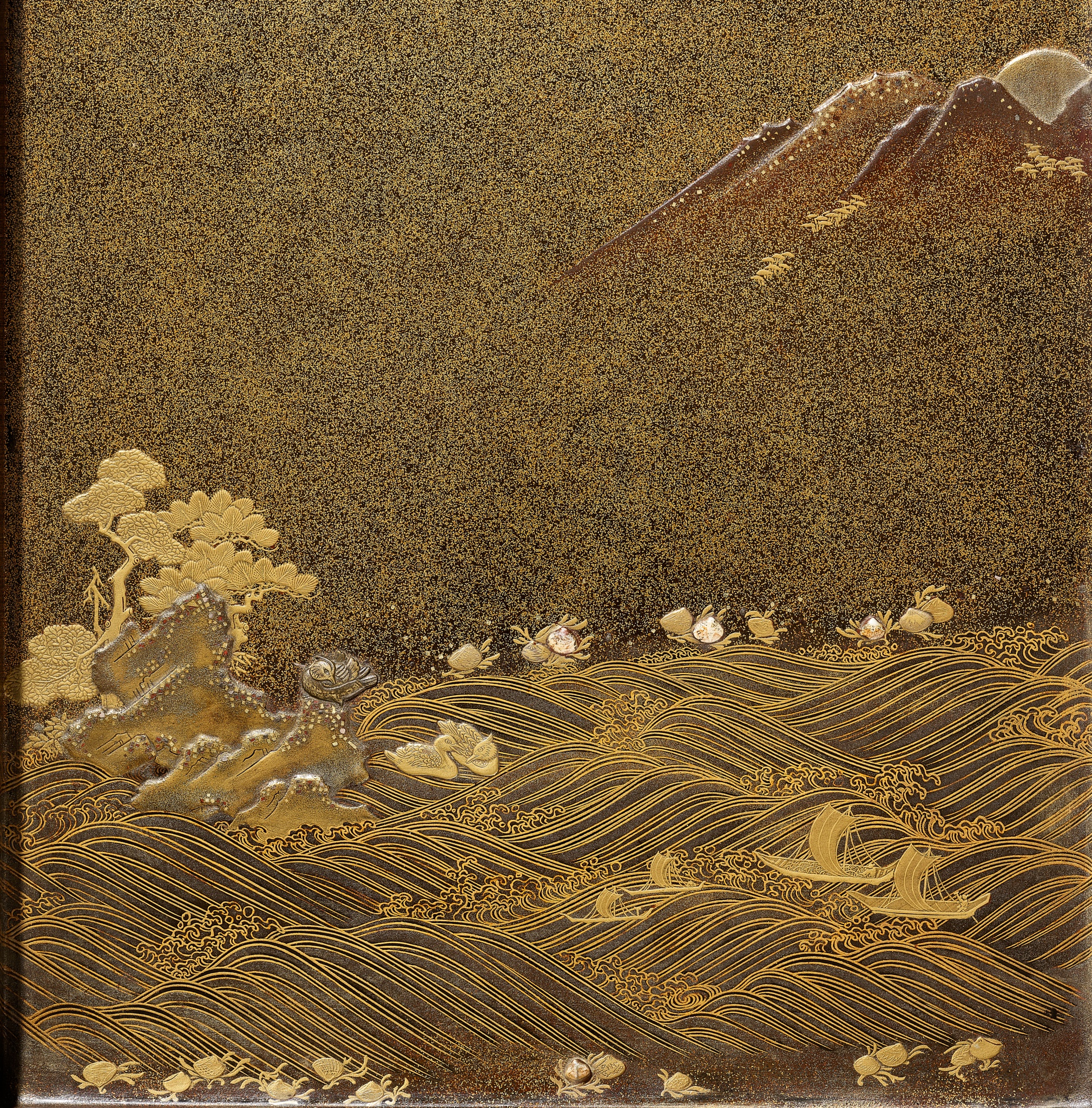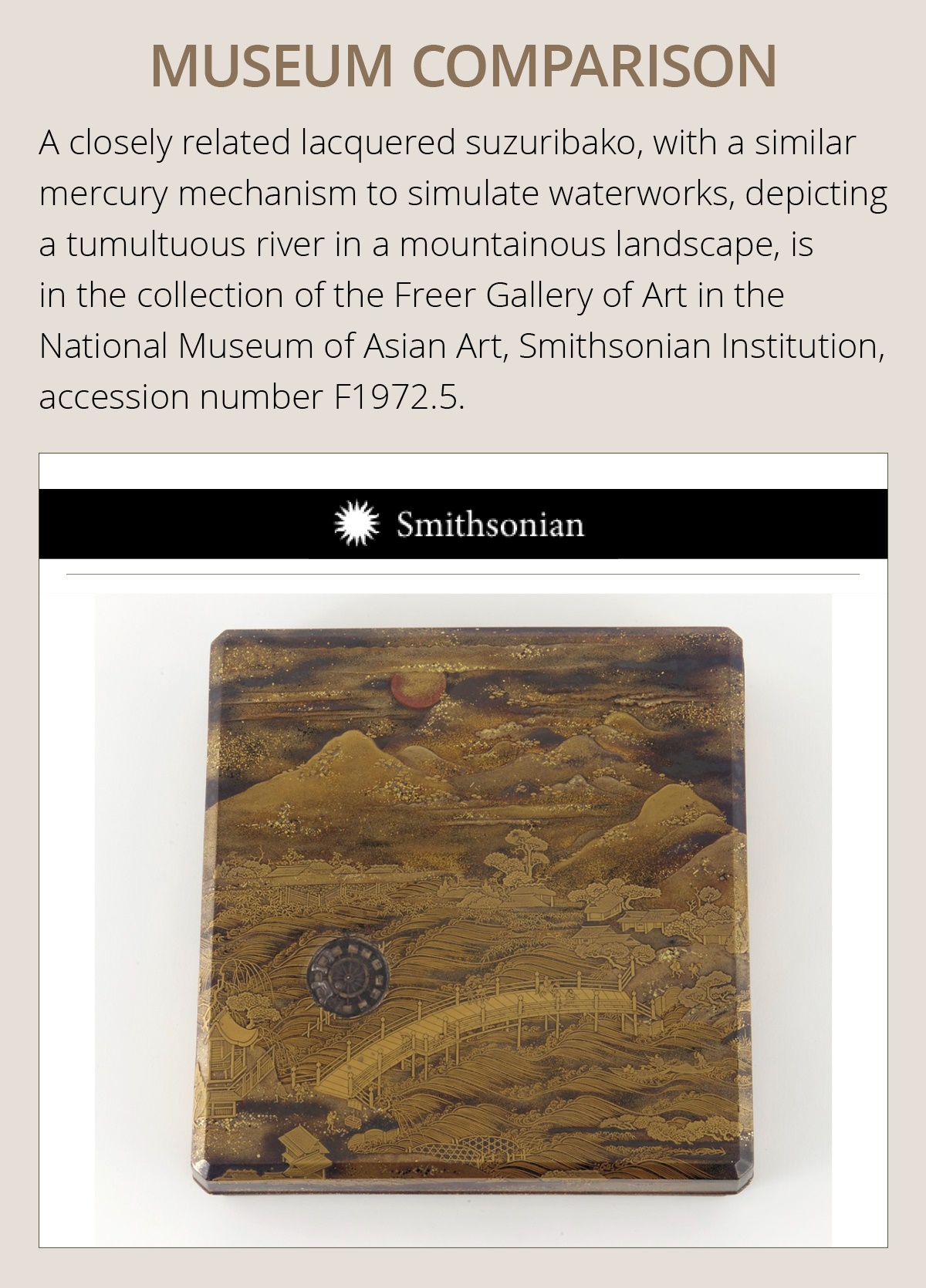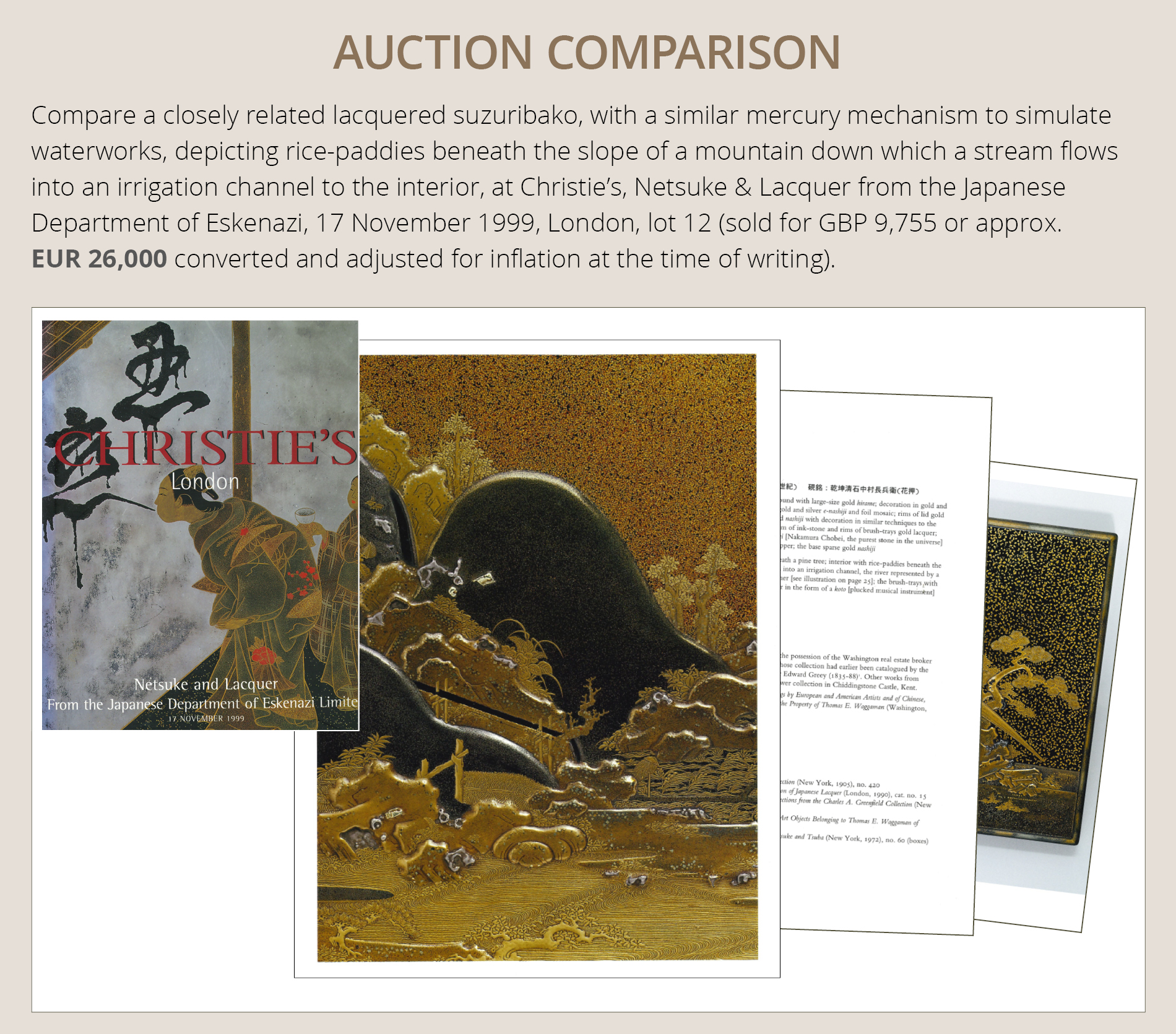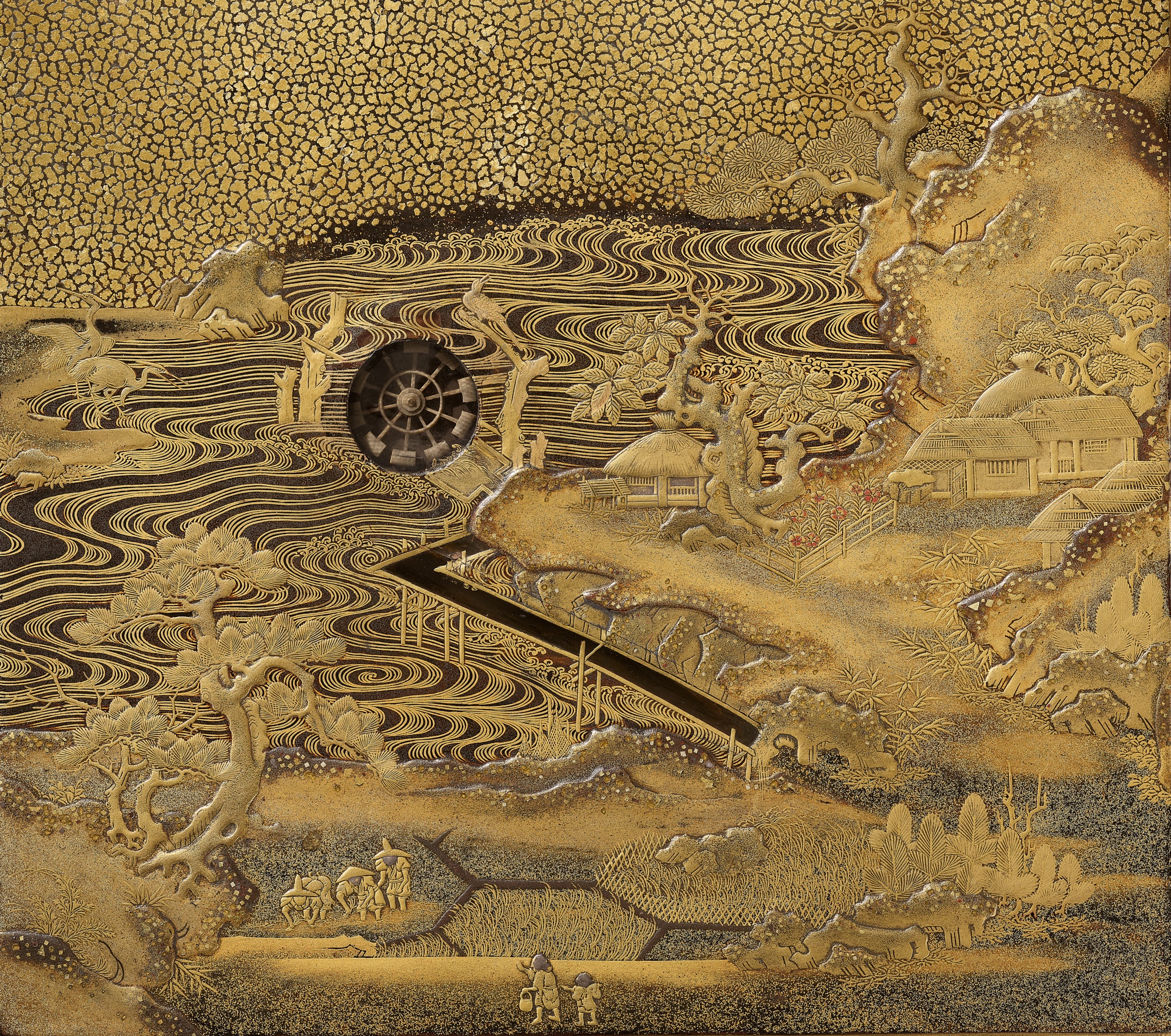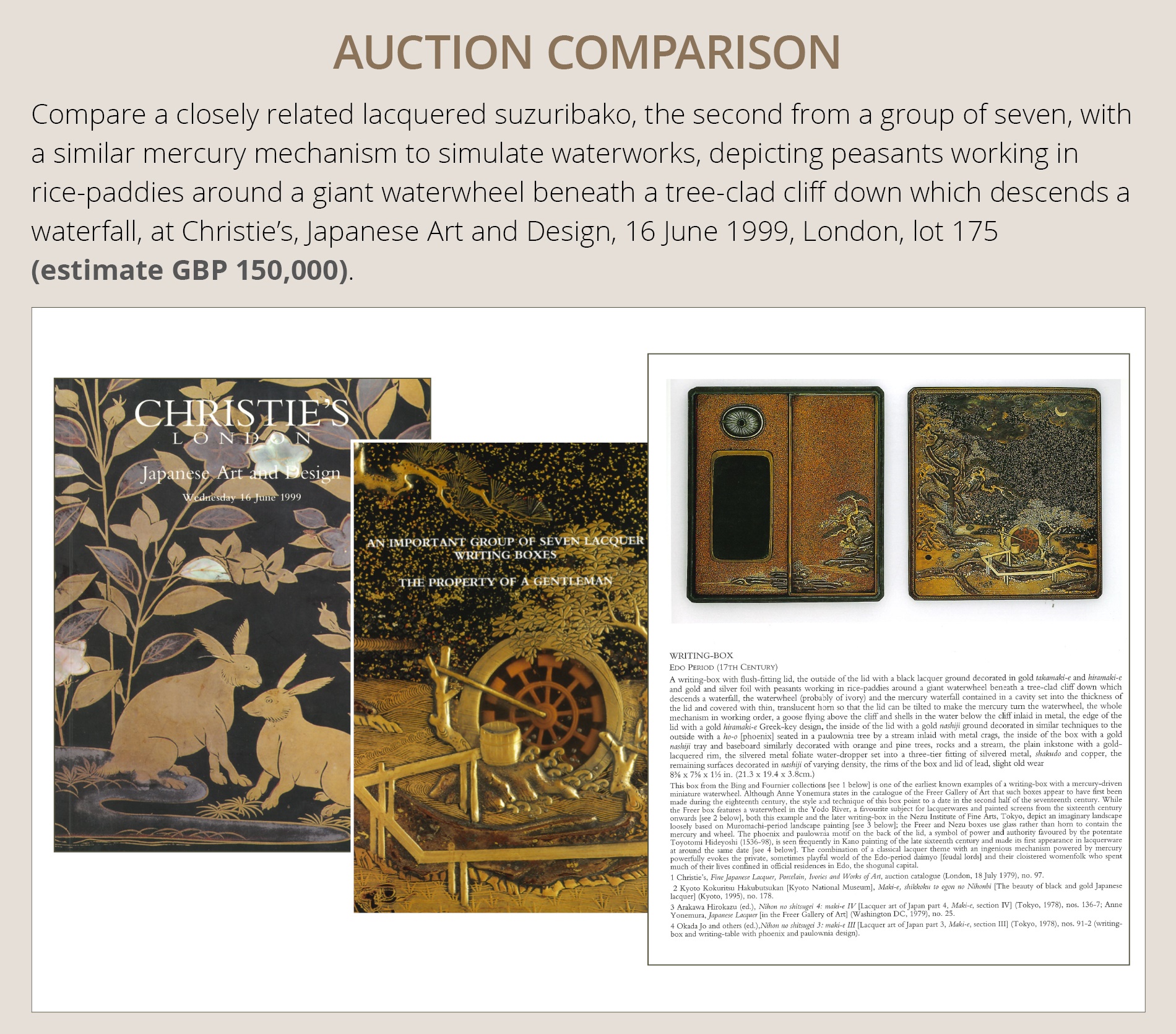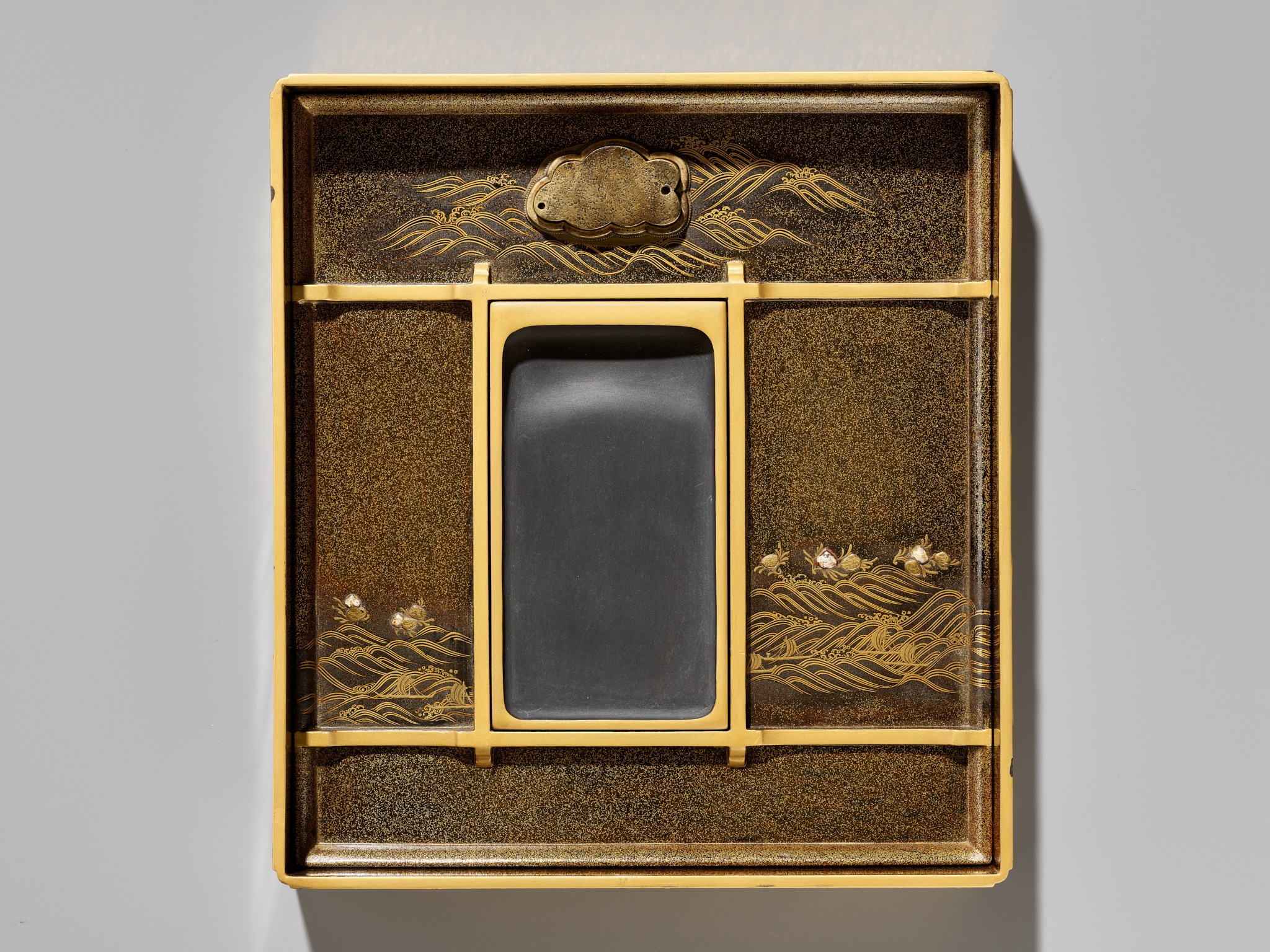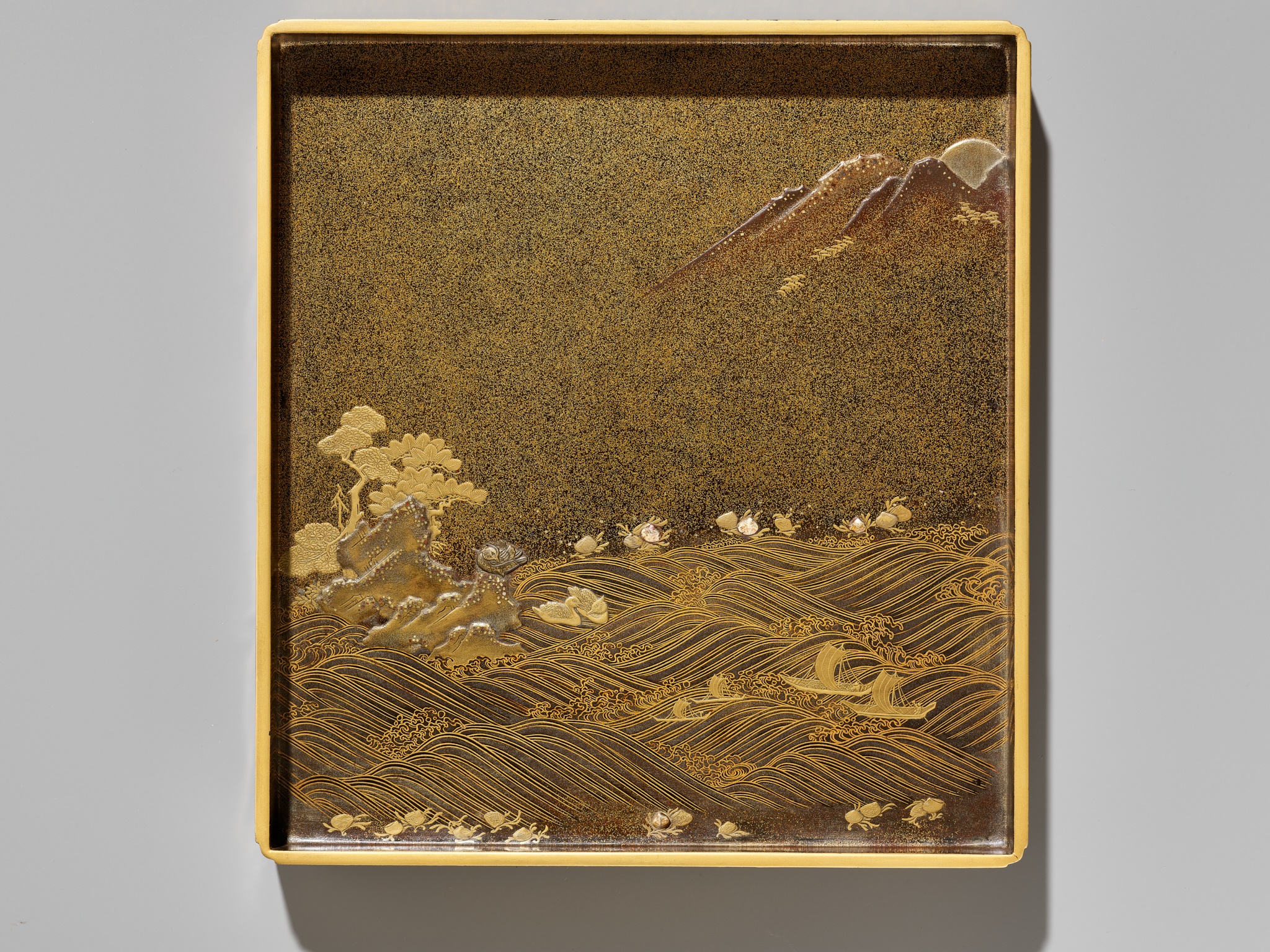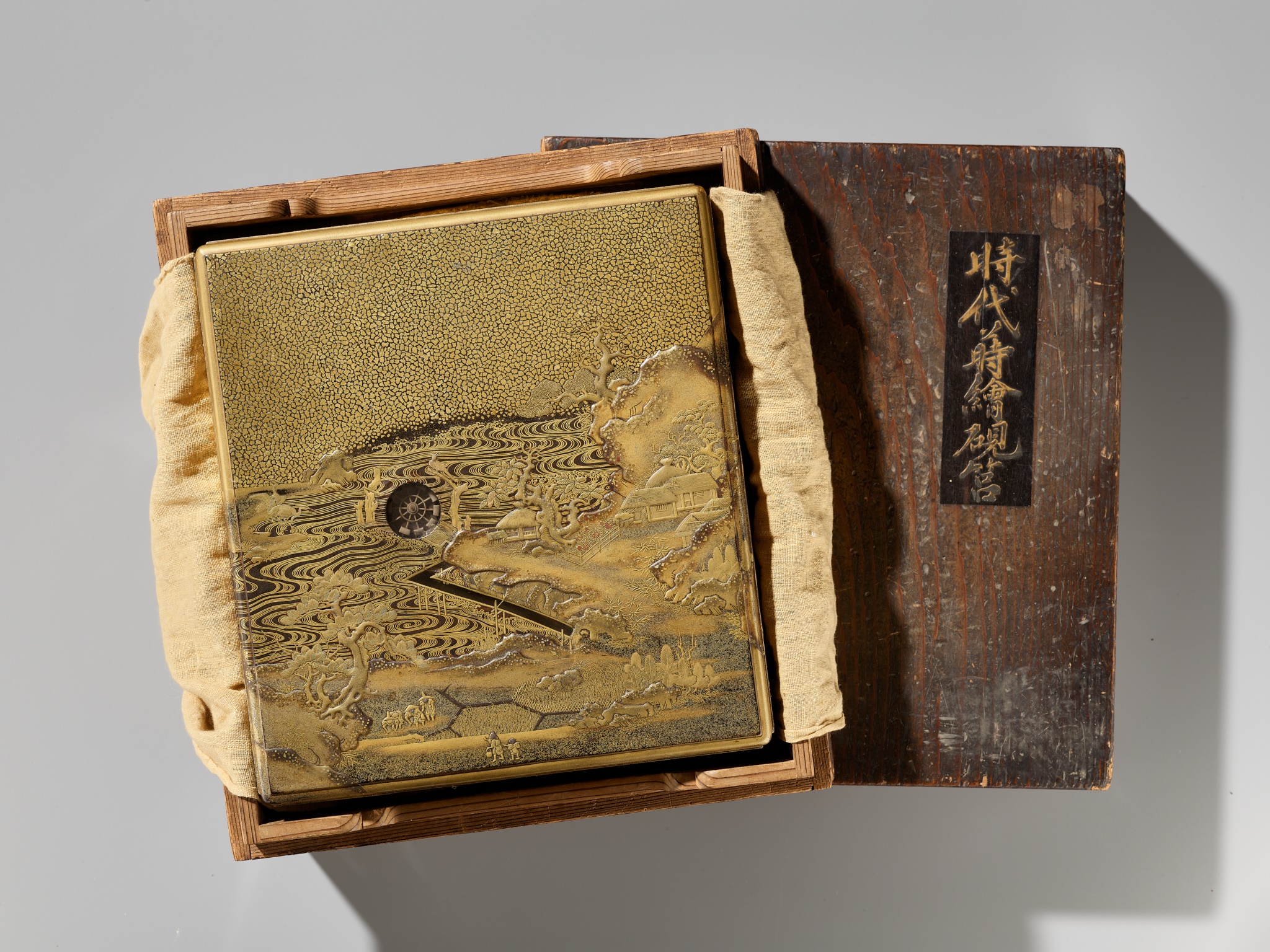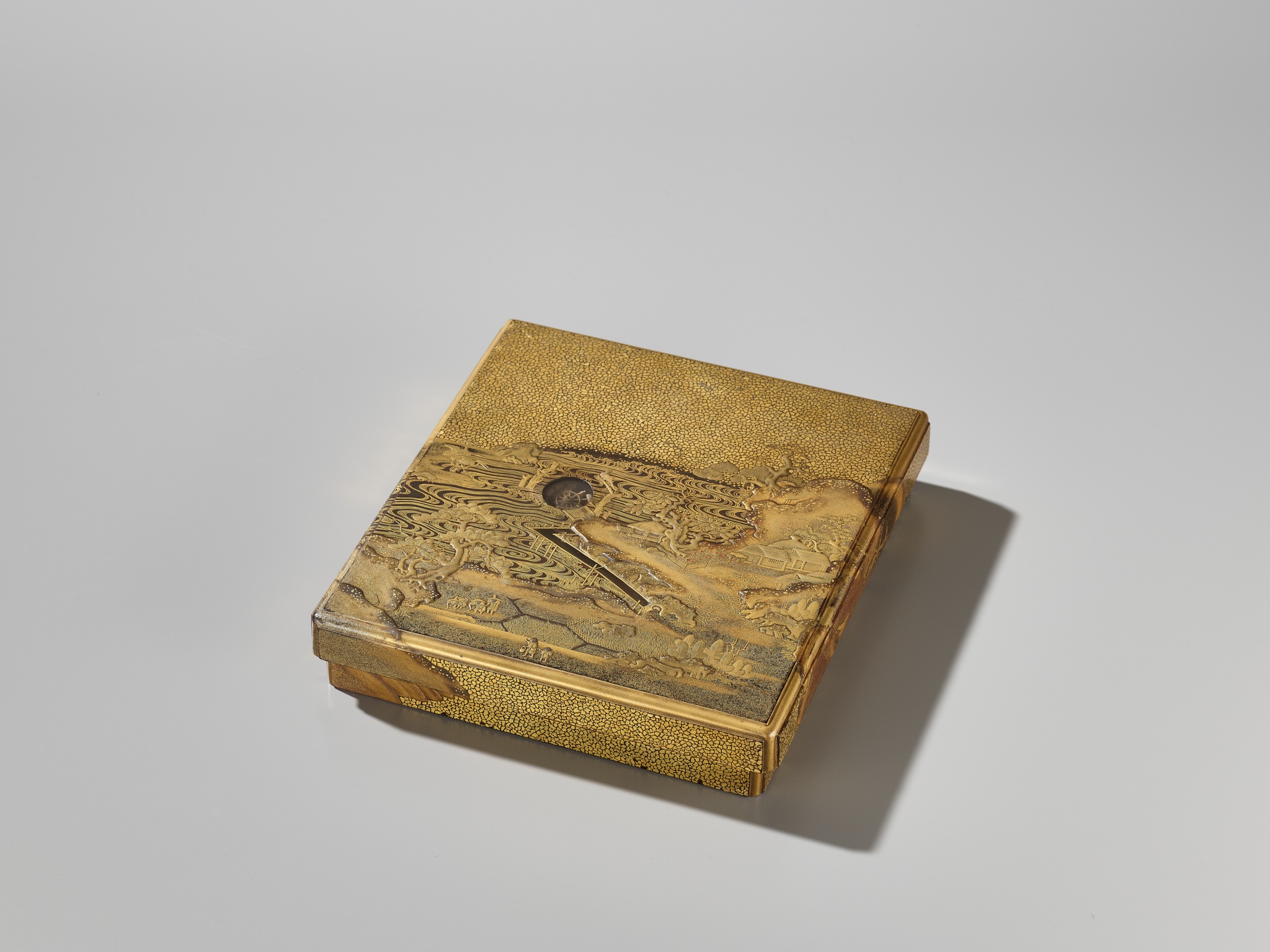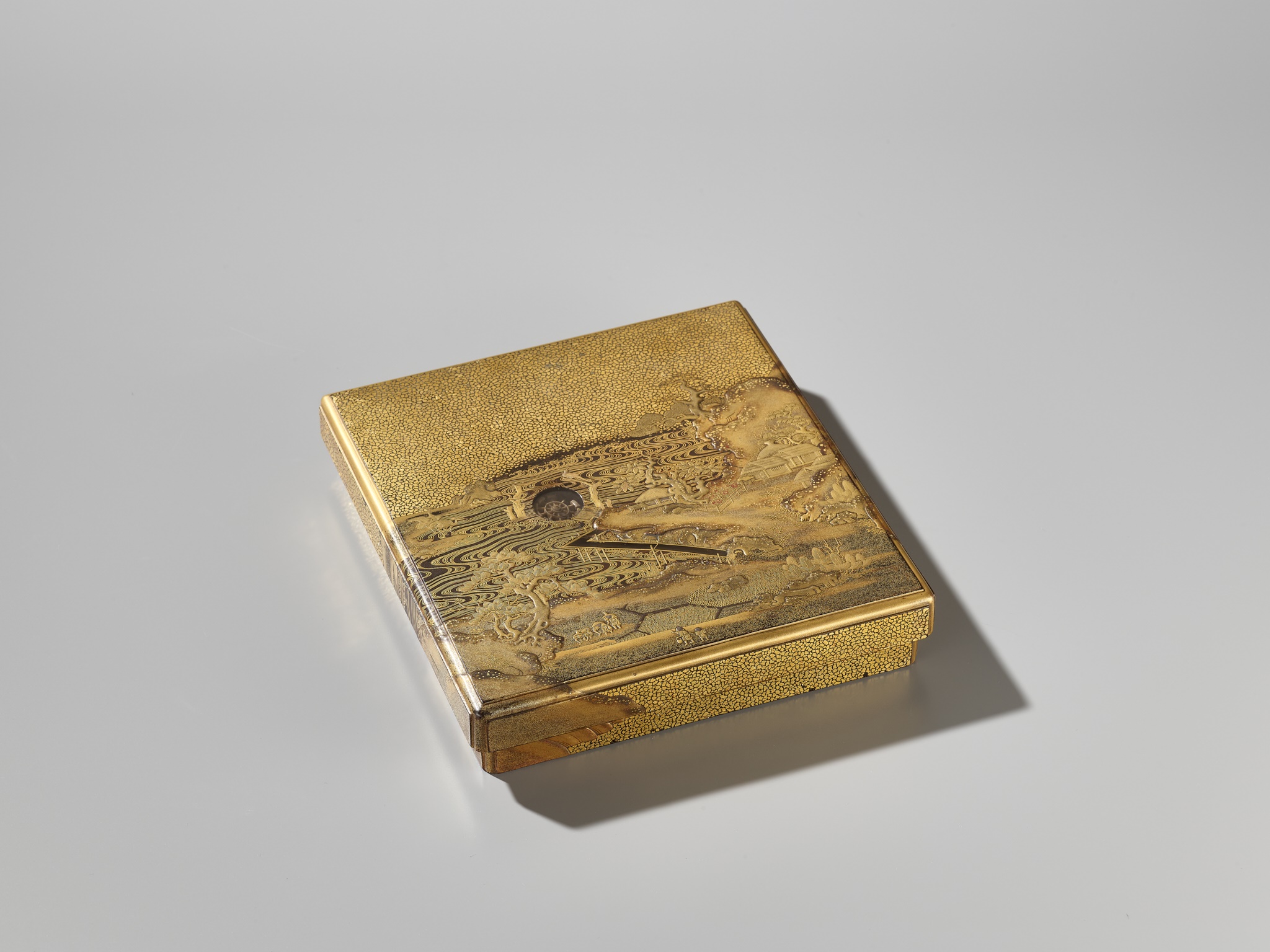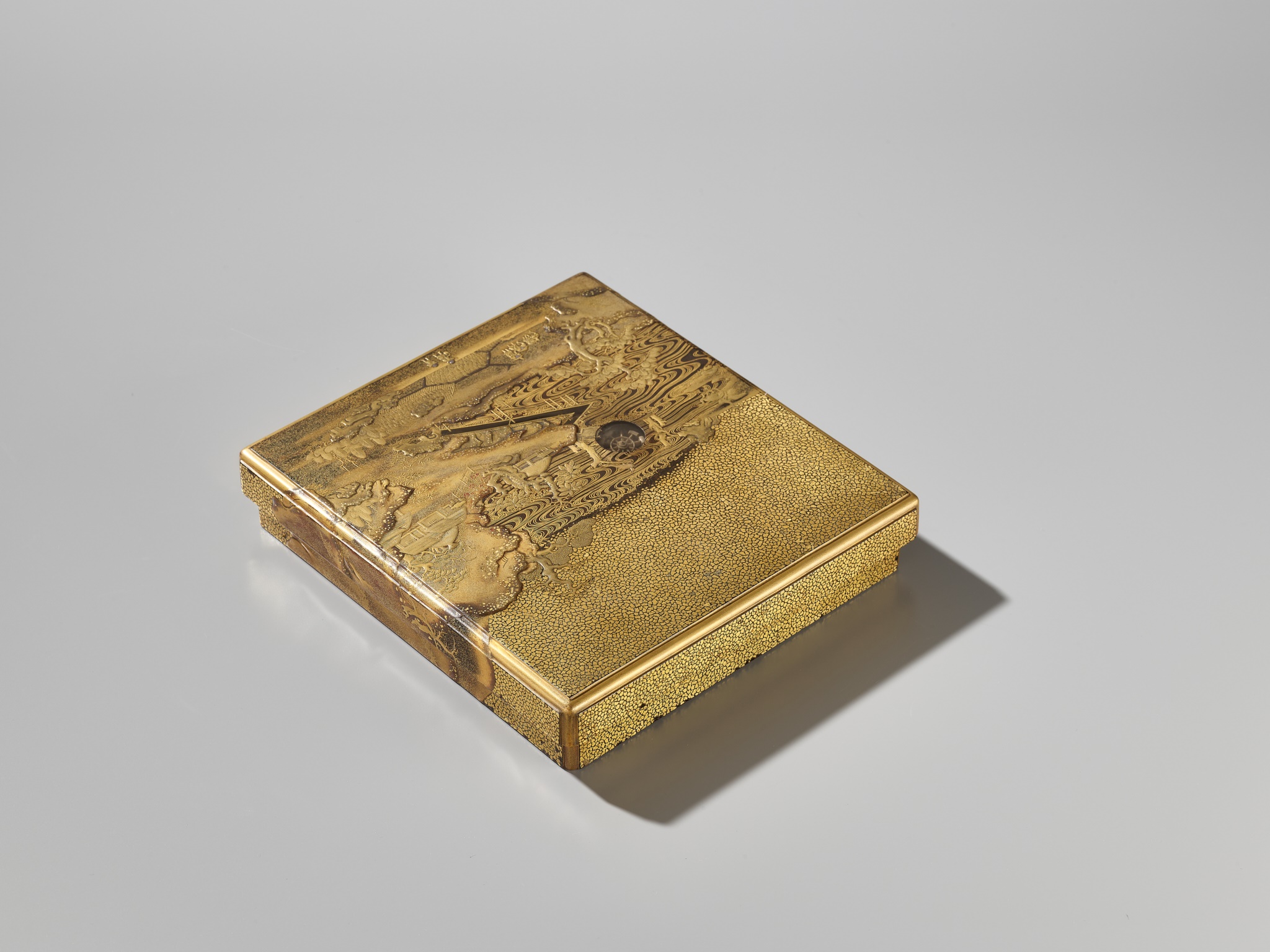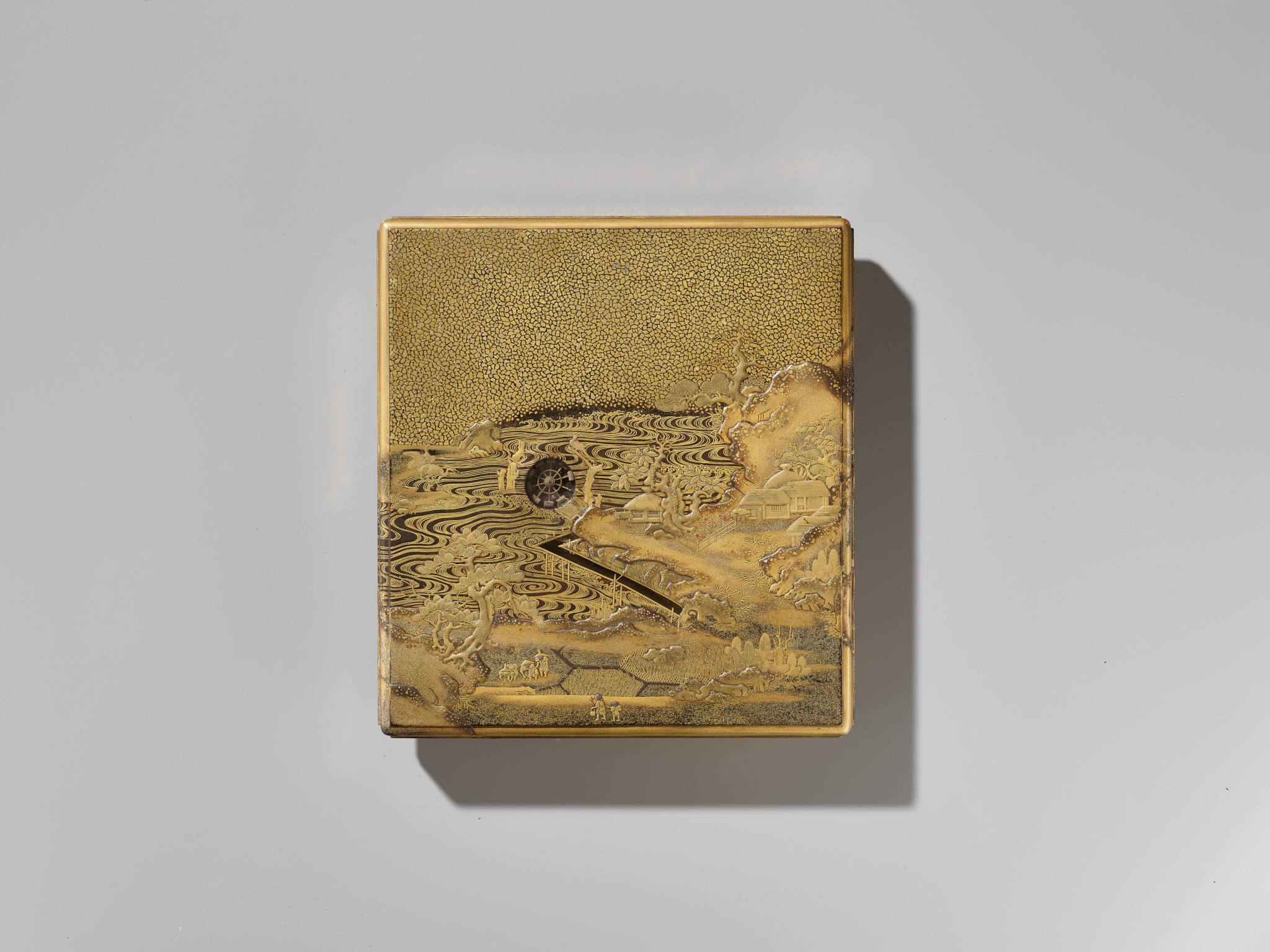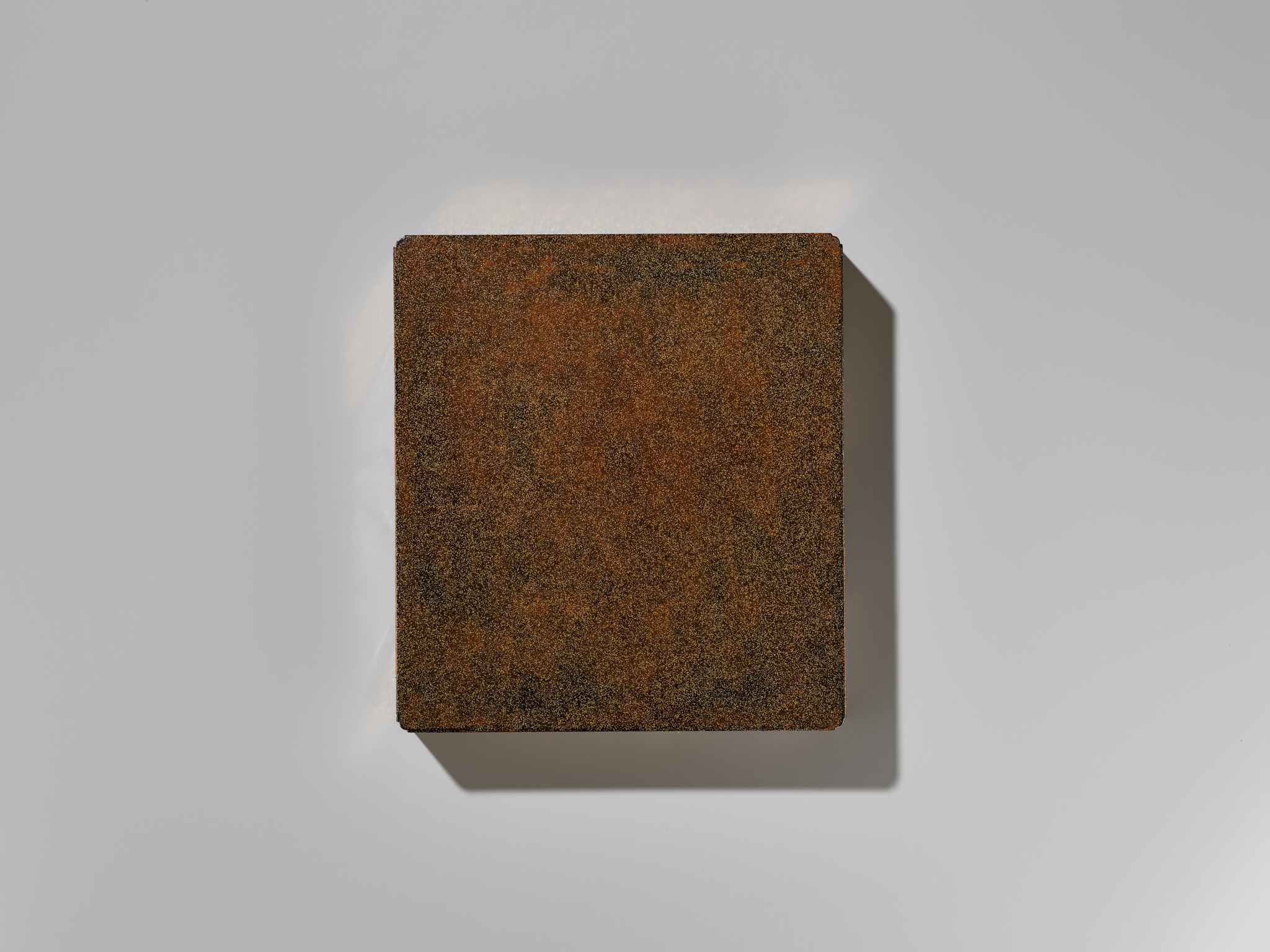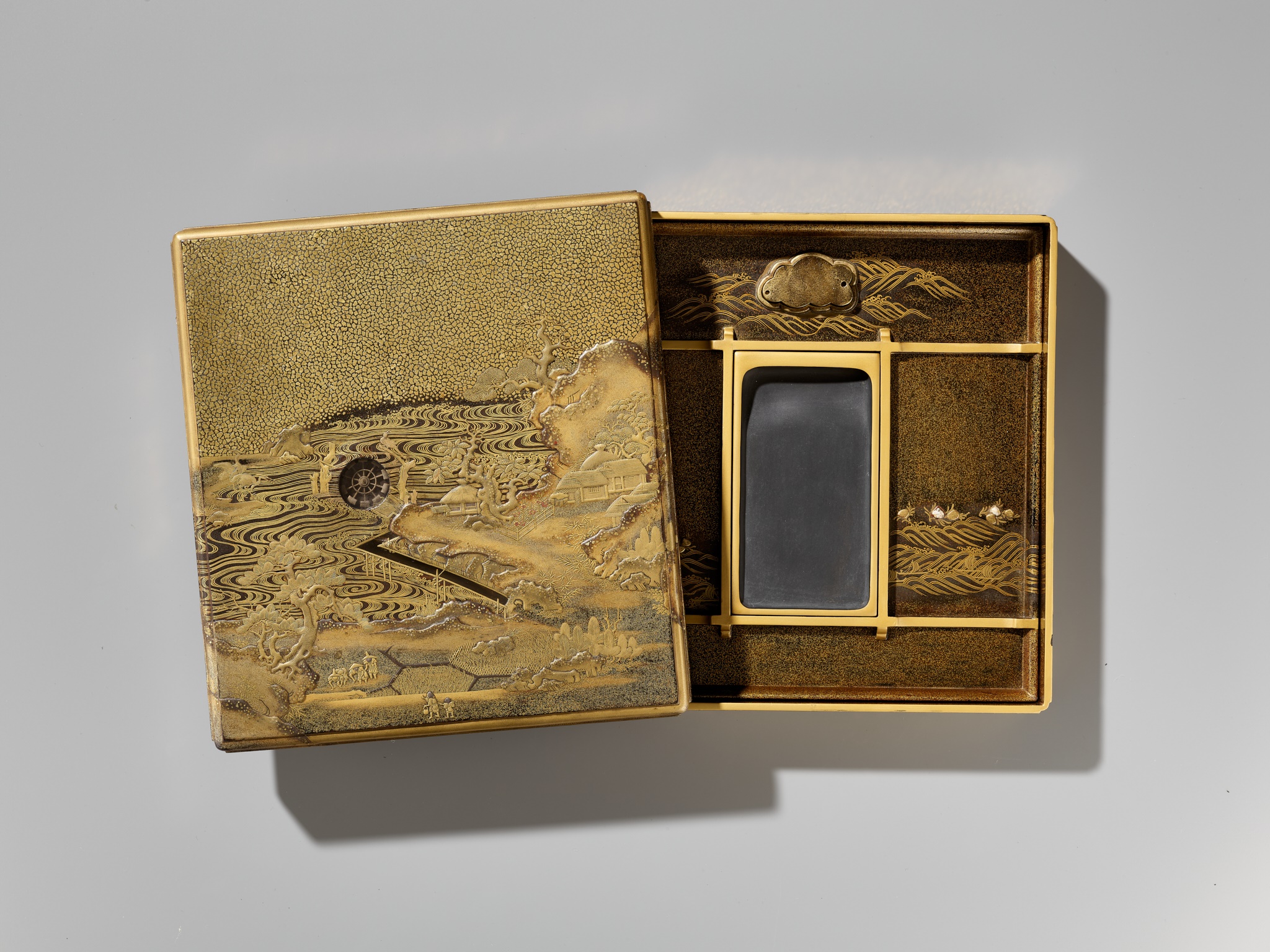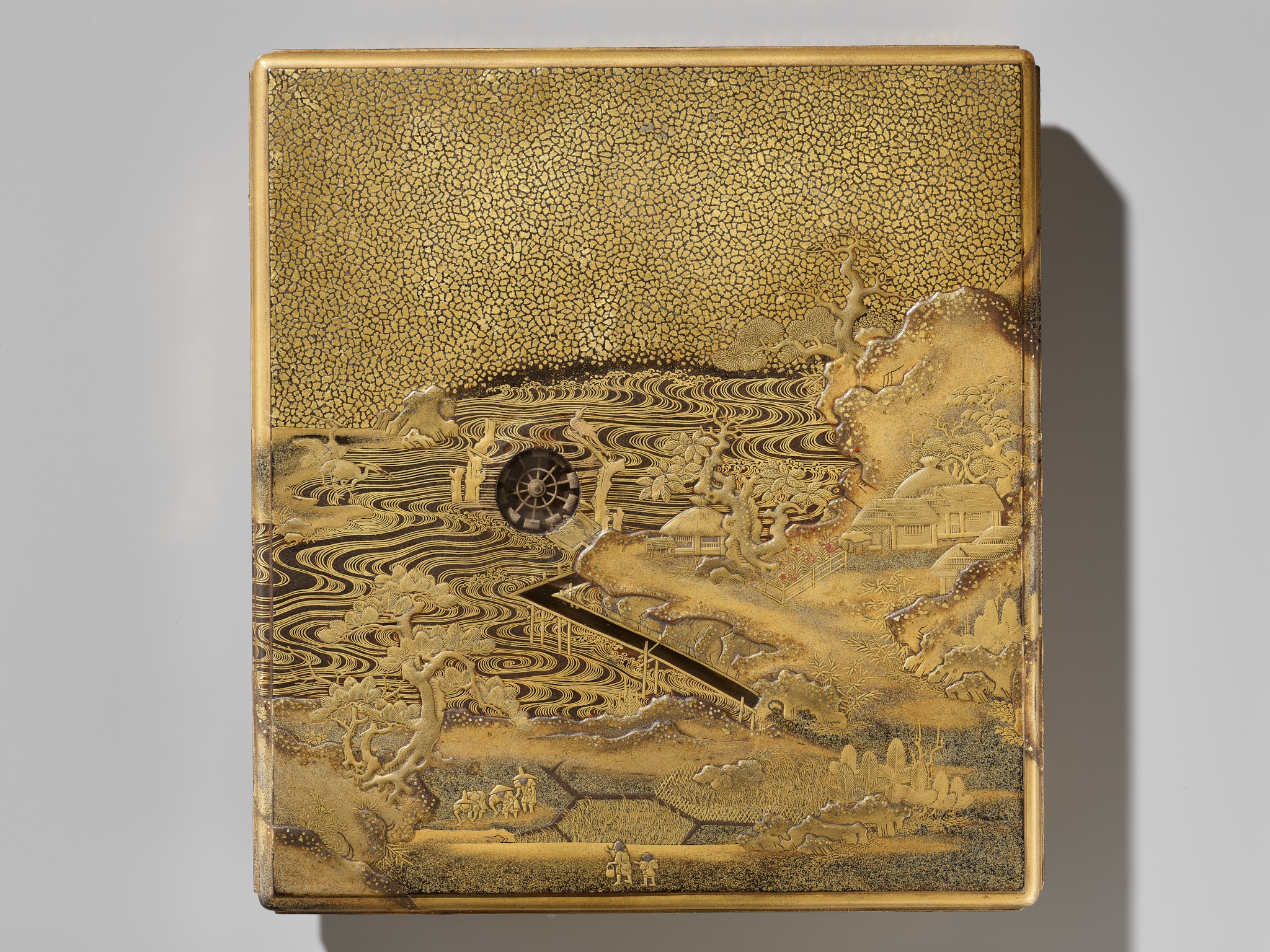22
A SUPERB LACQUER SUZURIBAKO WITH A 'WATERWHEEL' MERCURY MECHANISM
A SUPERB LACQUER SUZURIBAKO WITH A 'WATERWHEEL' MERCURY MECHANISM
Japan, second half of 18th century, Edo period (1615-1868)
Of rectangular form with recessed gold fundame edges, bearing a superb gyobu nashiji ground finely decorated in gold, brown, and red hiramaki-e and takamaki-e with kirigane and e-nashiji with farmers working in rice-paddies, below a bone waterwheel and mercury waterfall contained in a cavity set into the thickness of the lid and covered with glass or crystal so that it can be tilted to make the mercury turn the waterwheel, the water running from the waterwheel through a channel onto the rice paddies, further with craggy rockwork, gnarled trees, huts and buildings and two cranes. The base and interior of rich nashiji, the interior further with gold fundame edges, the cover similarly decorated with a bird perched on a rocky outcrop over two ducks swimming in the gushing water with sailing boats and lined with clam shells, the bird and some of the shells subtly inlaid with glazed ceramic, all below mountains in the background, the roaring sea with boats and shells repeated on the removable ita (baseboard) fitted with a cloud-form gilt-metal waterdropper (suiteki) and rectangular slate inkstone (suzuri). With an old wood tomobako inscribed to the lid Jidai makie suzuribako ('An old period piece, lacquer writing box'), and a protective cloth.
SIZE 4.4 x 24.6 x 22.5 cm
Condition: Very good condition, minor wear, traces of use, few fine age cracks to the top of the cover, minor flaking to lacquer here and there, mostly to interior edges. The mercury mechanism in full working order.
During the seventeenth century, lacquer craftsmen working on very high-quality writing boxes came up with a decorative device which was to be repeated from time to time until the latter part of the nineteenth century. Waterfalls and waterwheels depicted by partly filling small glass or horn-topped reservoirs with mercury only rarely appear on the market, but when they do, they remain as fascinating to the modern eye as they must have been to that of the seventeenth-century client. The novelty of these writing boxes did not in any way diminish the seriousness of the craftsman's application of his work.
These mechanisms are usually set into the outside of the covers of writing boxes and, rarely, smaller boxes and inro; when the piece is tilted backwards, the mercury retires into the invisible top part of the reservoir. When it is tilted in the opposite direction towards the vertical, mercury is released through a smaller channel than that through which it disappeared, giving the impression of light on ripples of cascading water, turning the waterwheel at the foot of the fall, and finishing its journey in a pool beyond.
The 'waterworks' on the present lid actually make a sound as they run. Inside the lid is a reservoir of mercury and when the lid is held vertically, the mercury streams down the falls and the aqueduct with a gurgling sound. The mercury flows for as long as around fourteen seconds when the lid is lifted and recharges invisibly and silently when the lid is pointed downward. Since the surfaces of the falls and aqueduct are glass, the sparkling flow is visible as well as audible.
Literature comparison:
A closely related Genroku-period lacquered suzuribako, with a similar mercury mechanism to simulate waterworks, showing a nobleman and his attendants crossing a bridge with a working waterwheel beside it, is illustrated in Casal, V.A. (1961) Japanese Art Lacquers, no. 27. pl. XII.
Museum comparison:
A closely related lacquered suzuribako, with a similar mercury mechanism to simulate waterworks, depicting a tumultuous river in a mountainous landscape, is in the collection of the Freer Gallery of Art in the National Museum of Asian Art, Smithsonian Institution, accession number F1972.5.
Auction comparison:
Compare a closely related lacquered suzuribako, with a similar mercury mechanism to simulate waterworks, depicting rice-paddies beneath the slope of a mountain down which a stream flows into an irrigation channel to the interior, at Christie's, Netsuke & Lacquer from the Japanese Department of Eskenazi, 17 November 1999, London, lot 12 (sold for GBP 9,755 or approx. EUR 26,000 converted and adjusted for inflation at the time of writing). Compare a closely related lacquered suzuribako, the second from a group of seven, with a similar mercury mechanism to simulate waterworks, depicting peasants working in rice-paddies around a giant waterwheel beneath a tree-clad cliff down which descends a waterfall, at Christie's, Japanese Art and Design, 16 June 1999, London, lot 175 (estimate GBP 150,000).
A SUPERB LACQUER SUZURIBAKO WITH A 'WATERWHEEL' MERCURY MECHANISM
Japan, second half of 18th century, Edo period (1615-1868)
Of rectangular form with recessed gold fundame edges, bearing a superb gyobu nashiji ground finely decorated in gold, brown, and red hiramaki-e and takamaki-e with kirigane and e-nashiji with farmers working in rice-paddies, below a bone waterwheel and mercury waterfall contained in a cavity set into the thickness of the lid and covered with glass or crystal so that it can be tilted to make the mercury turn the waterwheel, the water running from the waterwheel through a channel onto the rice paddies, further with craggy rockwork, gnarled trees, huts and buildings and two cranes. The base and interior of rich nashiji, the interior further with gold fundame edges, the cover similarly decorated with a bird perched on a rocky outcrop over two ducks swimming in the gushing water with sailing boats and lined with clam shells, the bird and some of the shells subtly inlaid with glazed ceramic, all below mountains in the background, the roaring sea with boats and shells repeated on the removable ita (baseboard) fitted with a cloud-form gilt-metal waterdropper (suiteki) and rectangular slate inkstone (suzuri). With an old wood tomobako inscribed to the lid Jidai makie suzuribako ('An old period piece, lacquer writing box'), and a protective cloth.
SIZE 4.4 x 24.6 x 22.5 cm
Condition: Very good condition, minor wear, traces of use, few fine age cracks to the top of the cover, minor flaking to lacquer here and there, mostly to interior edges. The mercury mechanism in full working order.
During the seventeenth century, lacquer craftsmen working on very high-quality writing boxes came up with a decorative device which was to be repeated from time to time until the latter part of the nineteenth century. Waterfalls and waterwheels depicted by partly filling small glass or horn-topped reservoirs with mercury only rarely appear on the market, but when they do, they remain as fascinating to the modern eye as they must have been to that of the seventeenth-century client. The novelty of these writing boxes did not in any way diminish the seriousness of the craftsman's application of his work.
These mechanisms are usually set into the outside of the covers of writing boxes and, rarely, smaller boxes and inro; when the piece is tilted backwards, the mercury retires into the invisible top part of the reservoir. When it is tilted in the opposite direction towards the vertical, mercury is released through a smaller channel than that through which it disappeared, giving the impression of light on ripples of cascading water, turning the waterwheel at the foot of the fall, and finishing its journey in a pool beyond.
The 'waterworks' on the present lid actually make a sound as they run. Inside the lid is a reservoir of mercury and when the lid is held vertically, the mercury streams down the falls and the aqueduct with a gurgling sound. The mercury flows for as long as around fourteen seconds when the lid is lifted and recharges invisibly and silently when the lid is pointed downward. Since the surfaces of the falls and aqueduct are glass, the sparkling flow is visible as well as audible.
Literature comparison:
A closely related Genroku-period lacquered suzuribako, with a similar mercury mechanism to simulate waterworks, showing a nobleman and his attendants crossing a bridge with a working waterwheel beside it, is illustrated in Casal, V.A. (1961) Japanese Art Lacquers, no. 27. pl. XII.
Museum comparison:
A closely related lacquered suzuribako, with a similar mercury mechanism to simulate waterworks, depicting a tumultuous river in a mountainous landscape, is in the collection of the Freer Gallery of Art in the National Museum of Asian Art, Smithsonian Institution, accession number F1972.5.
Auction comparison:
Compare a closely related lacquered suzuribako, with a similar mercury mechanism to simulate waterworks, depicting rice-paddies beneath the slope of a mountain down which a stream flows into an irrigation channel to the interior, at Christie's, Netsuke & Lacquer from the Japanese Department of Eskenazi, 17 November 1999, London, lot 12 (sold for GBP 9,755 or approx. EUR 26,000 converted and adjusted for inflation at the time of writing). Compare a closely related lacquered suzuribako, the second from a group of seven, with a similar mercury mechanism to simulate waterworks, depicting peasants working in rice-paddies around a giant waterwheel beneath a tree-clad cliff down which descends a waterfall, at Christie's, Japanese Art and Design, 16 June 1999, London, lot 175 (estimate GBP 150,000).
Fine Japanese Art
Sale Date(s)
Venue Address
Shipping information not yet avalable.
Important Information
Contact us via Wechat, our Wechat ID: GalerieZacke
We’ve updated our terms and conditions to better protect all serious and committed buyers from bidding against non-payers. Bidders must clarify all questions specifically about the objects before the auction. A sale cancellation of any kind after the fall of the hammer is not possible. The only exception to this fundamental rule is our guarantee of authenticity. We encourage you to read through these updates carefully (§34-50).
According to the general terms and conditions of business of Galerie Zacke Vienna, Founded 1968, SZA Versteigerungen & Vertriebs GmbH, 1070 Wien
WE ACCEPT THE FOLLOWING METHODS OF PAYMENTS:
• Cash
• Certified or personal check
• Bank transfer (please inquire to receive our bank account information)
• Credit card (Visa, MasterCard, Amex, Diners Club)
ESTIMATES AND STARTING PRICES
The auction will begin with the starting price and written bids will be accepted only with a minimum amount equivalent to the starting price.
SHIPPING AND TRANSPORT INSURANCE
For domestic shipping Galerie Zacke (hereinafter called “the company”) charges in average Eur 15,- to Eur 50,- per item, depending on size and weight. These fees cover the costs of packing and shipping. Fees for bulky or fragile items, or international shipping will be quoted upon request.
The purchased goods are transported at the risk of the customer following handover of the packaged item to the post office or another carrier which the customer agrees to through his/her submission of the purchase order. According to the specific wish of the customer, the auctioned goods may be insured for the value of the purchase price (highest bid and all surcharges). This insurance fee is 3% of the purchase price. For any lots with a purchase prices exceeding EUR 350,- the transport insurance will be automatically arranged by the company if it does not expressively receive the purchaser’s written denial of this service and signed waiver of claims. Payments due to the company under the insurance contract will be charged to the customer. The company is also entitled to assign claims under the insurance contract to the customer providing the terms of the insurance contract do not prevent this. In any case, the company is only required to make payment to the customer specifically if payment has effectively been received from the insurance company.
COLOR AND CONDITION
Auction lots will be exhibited for viewing prior to the auction, thus offering all interested customers the opportunity to examine the quality and condition of the works exhibited. The catalog illustrations are intended to assist customers during such preview. In illustrations, printed colors do not correspond exactly to the originals. The printed catalog images are not representative for the condition of the illustrated pieces. Hidden flaws and damages are indicated in the condition report. The illustrations in our online catalogs can be strongly magnified, so that most damages and restorations are well recognizable.
ENDANGERED SPECIES / CITES INFORMATION
Some items in this catalog may for example consist of ivory, rhinoceroshorn, tortoise shell, or some types of tropical wood, and are subject to the Convention on International Trade in Endangered Species of Wild Fauna and Flora [CITES]. Such items are marked with the symbol Ɏ on www.zacke.at and may only be exported outside the European Union after an export permit in accordance with CITES has been granted by the Austrian authorities. We would like to inform you that such licenses are typically not granted. For objects which have a low ivory content or have been proven beyond doubt to be in the EU before 1982, please contact our office for more information on how to obtain a CITES license.
COMPLAINTS
At its auctions, Galerie Zacke sells consigned lots on behalf of third-party consignors. For this reason, any complaints related to purchased lots must be in accordance with §32-48 of the general terms and conditions of business of Galerie Zacke, which can be found on www.zacke.at
IMPORTANT INFORMATION
Whenever making a bid, whether personally or via an agent, in writing, online, telephone, or in any other way, the bidder fully and unconditionally accepts the Terms of Auction, the ‘Important Information’ section in the auction catalog, the Terms and Conditions (AGB) of Galerie Zacke, §1-48, the Fee Tariff, and the Bidding Increments table, all as published on www.zacke.at on the day of the auction
THE ART LOSS REGISTER
All items starting above 2.000,- EUR have been checked by the Art Loss register.
Terms & Conditions
TERMS OF AUCTION
Buyer’s Premium 30% including VAT
Further information please read § 3
§ 1) The auction shall be carried out in accordance with the provisions of the rules of procedure of GALERIE ZACKE©, SZA VERSTEIGERUNGEN UND VERTRIEBS GMBH, MARIAHILFERSTRASSE 112, 1070 WIEN (hereinafter referred to as the company) as well as in accordance with sections 244-246 of the GEWERBEORDNUNG [Industrial Code] of 1994. The auction shall be carried out on commission. The auctioneer shall be entitled to withdraw lots exceptionally, to conduct the auction deviating from the order of the catalog numbers and to offer lots jointly. In the event of any dispute concerning a double bid or if the auctioneer has missed a bid, the auctioneer shall be entitled to revoke acceptance of a bid and to continue auctioning the item. The figures stated in the catalog shall be the highest bid in Euro (€) expected by the respective expert. As a rule, the bid shall be increased by 10% of the last bid. (See table of the bidding increments).
§ 2) The acceptance of a bid shall be granted to the highest bidder unless a hidden reserve has been agreed upon with the consignor of the item in question. Such a hidden reserve (also called limit or just reserve) shall be the minimum price under which the item will not be sold during the auction. This reserve will be disclosed upon request and after the auction only and may exceed the estimate. The auctioneer will in this case bid on behalf of the seller against all other bidders until the reserve has been reached. If a reserve is not reached during the auction, the auctioneer will knock down the item to the highest bidder at the final bid, but the sale will be conditional of the acceptance of this final bid by the seller. In this case the highest bidder shall be bound to his/her last bid for a term of 8 days starting with the day of the knockdown. If the winning bidder does not receive a written cancellation notice within this term of 8 days, the knockdown becomes unconditional and the sale is final. Typically, only a minority of all items in an auction have a hidden reserve.
§ 3) Most items shall be subject to differential taxation. A uniform surcharge of 25% plus the value added tax applicable to the surcharge to the amount of 20% shall be added to the achieved highest bid (final and highest bid). Thus, the surcharge shall be 30% of the final and highest bid in total. Items with added VAT are marked in the online catalog.
§ 4) In the event of sales abroad, the value added tax will be repaid if the item is sold to a country which is not a member country of the European Union (third country), the legal requirements are met, and the proof of exportation is provided. The value added tax shall not be shown separately on the invoice.
§ 5) The auction buyer must pay the purchase price immediately upon acceptance of the bid (final and highest bid plus 25% surcharge, plus the value added tax applicable to the surcharge to the amount of 20%, or the added VAT on top of the final price, when a lot is highlighted accordingly in the auction catalog). The company may grant an auction buyer a term of payment for the purchase price in whole or in part when this has been formally applied for in writing before the auction.
§ 6) In the event of a term of payment, or any payment delay, in whole or in part, the company shall be entitled to charge default interest (12% p.a.) as well as storage charges (2.4% pf the final and highest bid per month commenced) after 14 days upon acceptance of the bid. The item purchased at auction shall be handed over exclusively upon full payment of the purchase price including all costs and charges accrued since the acceptance of the bid.
§ 7) The buyer should take acquired items into possession, as far as possible, immediately or after the end of the auction. Items which have been fully paid for shall be handed over in our show rooms in GALERIE ZACKE, MARIAHILFERSTRASSE 112, 1070 VIENNA. If a deferred purchase price is not paid within the set period, the company shall be entitled to auction the item again in order to recoup its claim from the defaulting auction buyer. In this case, the defaulting auction buyer shall be liable to the company for the total loss of commission incurred by the company due to the re-auctioning as well as for any default interest and storage charges.
§ 8) The company shall be entitled to a lien on all items of the buyer irrespective of whether the buyer bought them within the scope of an auction or in free sale or the company secured ownership of these items otherwise. This lien shall serve to secure all current and future, qualified, limited and unmatured claims to which the company is entitled and which result from all legal transactions concluded with the buyer.
§ 9) The items received for auction will be exhibited and may be viewed prior to the auction. In doing so, the company shall give everyone the opportunity to check the nature and the condition of the exhibited items to the extent deemed possible within the scope of the exhibition. Every bidder shall be deemed to act on its own behalf unless it provides a written confirmation saying that it acts as a representative or agent of a well-known principal. The company may refuse bids; this shall particularly apply if a bidder who is unknown to the company or with whom the company has no business connections yet does not provide a security deposit before the auction. However, in principle there shall be no claim to accept a bid. If a bid has been refused, the previous bid shall remain effective.
§ 10) The company’s experts evaluate and describe the items received for auction and determine the starting prices unless otherwise stated in the catalog or expert opinion. The information concerning production technique or material, state of preservation, origin, design and age of an item is based on published or otherwise generally accessible (scientific) findings concluded by the company’s expert with the necessary care and accuracy. The company shall warrant to the buyer according to §34-38 of the AGB (Terms and Conditions) that properties are correct provided that any complaints referring to this are made within 45 days after the auction day. Subsequent complaints shall be excluded in principle. The company shall not be liable for any further information in the catalog and expert opinion as well. This shall also apply to illustrations in the catalog. The purpose of these illustrations is to guide the potential buyer during the preview. They shall not be authoritative for the condition or the characteristics of the pictured item. The published condition reports shall only mention defects and damage affecting the artistic or commercial value significantly. Complaints concerning the price shall be excluded upon acceptance of the bid. The company reserves the right to amend the catalog online prior to the auction. These amendments shall also be made public orally by the auctioneer during the auction. In this case, the company shall be liable for the amendment only. All items offered may be checked prior to the auction. These items are used. Any claims for damages exceeding the liability named above and resulting from other material defects or other defects of the item shall be excluded. When making the bid, the bidder confirms that he/she has inspected the item prior to the auction and has made sure that the item corresponds to the description.
§ 11) If a customer is not able to participate in an auction personally, the company shall accept purchase orders. These orders may be placed in writing via mail, e-mail, fax, www.zacke.at or a third party bidding platform. In the case of a purchase order placed by phone or orally, the company shall reserve the right to make the performance dependent on a confirmation from the principal communicated in writing. Furthermore, the company shall not be liable for the performance of purchase orders. Equal purchase orders or live bids will be considered in the order of their receipt. Bids which below the estimate shall be exhausted completely. Bids which do not correspond to the increments determined by the company (see bidding increment table) will be rounded up to the next higher increment. The table of these increments can be sent upon request. The written bid (purchase order) must include the item, the catalog number and the offered top bid limit which is quoted as the amount of the acceptance of the bid without buyer’s commission and without taxes. Ambiguities shall be carried by the bidder. A purchase order which has already been placed may only be cancelled if the written withdrawal is received by the company at least 72 hours prior to the beginning of the auction.
§ 12) The company may refuse a purchase order without explanation or make its execution dependent on payment of a security deposit. In the event of an unsuccessful order, such a deposit will be reimbursed by the company within 5 working days. Processing of purchase orders is free of charge.
§ 13) Every seller shall in principle be entitled to withdraw the items offered for auction until the start of the auction. Therefore, it is impossible to assume liability or to give warranty for the actual offering.
§ 14) Paid items must be collected within 30 days after payment. Items which have not been collected may be re-offered without further communication at the starting price from the recent auction reduced by 50%. Items which have not been collected within 30 days after the auction or for which the company does not receive any proper shipping instructions stating the type of shipping and the address of dispatch (independent of a possibly placed purchase order) shall be stored at the owner’s risk. Furthermore, the company shall be entitled to store items which have been purchased at auction and paid but not collected at the buyer ś risk and expense, including the costs for an insurance, with a forwarding agency. It shall be understood that the provision concerning the re-auctioning of unpaid and paid but not collected items must also apply to items not exhibited or stored on the premises of the company. The ownership shall be transferred to the buyer at the time of handing over the issuing note.
§ 15) In the case of mixed lots with a starting price of less than EUR 350.00, the company shall not warrant for the completeness or correctness of the individual items within a mixed lot.
§ 16) A registration for a bid by telephone for one or several items shall automatically represent a bid at the starting price of these items. If the company cannot reach a bidder by telephone, it will bid the starting price on behalf of this bidder when the respective lot is up for auction.
§ 17) Payments made to the company by mistake (through the payer ś fault) (e. g. due to miscalculation of the exchange rate by the payer) or payments made to the company for the same invoice several times shall be compensated in form of a credit note for goods for an indefinite period of time. The repayment of such payments in cash shall be excluded.
§ 18) Certain auction lots may exist several times (multiples). In such a case, the auctioneer may accept a second, third or even more bids from the underbidder(s). In this case, the text in the catalog and not the illustration shall be exclusively binding with regard to the warranty.
§ 19) The company reserves the right to assign to the buyer all rights and obligations resulting from the contractual relationship between the company and the seller by way of a respective declaration, as well as to assign to the seller all rights and obligations resulting from the contractual relationship between the company and the buyer by way of a respective declaration, in each case in terms of a complete assignment of contract with the result that the contractual relationship - following the submission of the aforementioned declarations by the company – shall exclusively be between the seller and the buyer, all of which is in accordance with the basic model of the commission agreement. Buyers and sellers shall already now give their explicit consent to this contract assignment.
§ 20) The place of performance of the contract brought about between the company on the one hand and the seller as well as the buyer on the other hand shall be the place of business of the company. The legal relationships and contracts existing between the company, the sellers and the buyers shall be subject to Austrian law. The company, the sellers and the buyers shall agree to settle all disputes resulting from, concerning and in connection with this contract before the territorially competent court of Vienna.
§ 21) The export of certain art objects from Austria shall require a permit from the Bundesdenkmalamt [Federal Monuments Office]. The company will orally provide information about art objects for which such export permit will probably not be granted at the beginning of the auction.
§ 22) Whenever making a bid, whether personally or via an agent, in writing, online, telephone, or in any other way, the bidder fully and unconditionally accepts the Terms of Auction, the ‘Important Information’ section in the auction catalog, the Terms and Conditions (AGB) of Galerie Zacke, §1-48, the Fee Tariff, and the Bidding Increments table, all as published on www.zacke.at on the day of the auction.



































